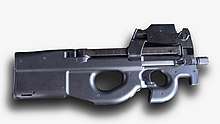Submachine gun
A submachine gun, abbreviated SMG, is a magazine-fed, automatic carbine designed to fire handgun cartridges. The term "submachine gun" was coined by John T. Thompson, the inventor of the Thompson submachine gun,[1] to describe its design concept as an automatic firearm with comparatively much inferior firepower (hence the prefix "sub-") than a proper machine gun.
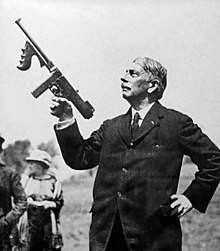
The submachine gun was developed during World War I (1914–1918) as close quarter offensive weapons, mainly for trench raiding. At its peak during World War II (1939–1945), millions of SMGs were made for use by regular troops, clandestine commandos and partisans alike. After the war, new SMG designs appeared frequently.[2] However, by the 1980s, SMG usage decreased.[2] Today, submachine guns have been largely replaced by assault rifles,[2] which have a longer effective range and are capable of penetrating the helmets and body armor used by modern infantry.[3] However, submachine guns are still used by military special forces and police SWAT teams for close quarters battle (CQB) because they are "a pistol-caliber weapon that's easy to control, and less likely to overpenetrate the target".[3]
History
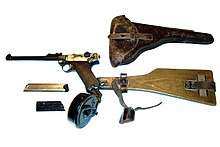
World War I
During World War I, the Austrians introduced the world's first machine pistol: the Steyr Repetierpistole M1912/P16. The Germans also experimented with machine pistols by converting pistols such as the Mauser C96 and Luger P-08 from semi-automatic to fully automatic operation and adding detachable stocks. Carbine-type automatic weapons firing pistol rounds were developed during the latter stages of World War I by Italy, Germany and the United States. Their improved firepower and portability offered an advantage in trench warfare.[4]
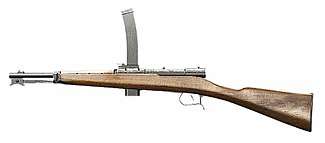
In 1915, the Italians introduced the Villar-Perosa aircraft machine gun. It fired pistol-caliber 9mm Glisenti ammunition, but was not a true submachine gun, as it was originally designed as a mounted weapon. This odd design was then modified into the OVP 1918 carbine-type submachine gun, which then evolved into the 9×19mm Parabellum Beretta Model 1918 after the end of World War I. Both the OVP 1918 and the Beretta 1918 had a traditional wooden stock, a 25-round top-fed box magazine, and had a cyclic rate of fire of 900 rounds per minute.
The Germans initially used heavier versions of the P08 pistol equipped with a detachable stock, larger-capacity snail-drum magazine and a longer barrel. By 1918, Bergmann Waffenfabrik had developed the 9 mm Parabellum MP 18, the first practical submachine gun. This weapon used the same 32-round snail-drum magazine as the Luger P-08. The MP 18 was used in significant numbers by German stormtroopers employing infiltration tactics, achieving some notable successes in the final year of the war. However, these were not enough to prevent Germany's collapse in November 1918. After World War I, the MP 18 would evolve into the MP28/II SMG, which incorporated a simple 32-round box magazine, a semi & full auto selector, and other minor improvements.[5]
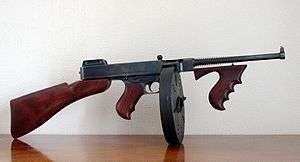
The .45 ACP Thompson submachine gun had been in development at approximately the same time as the Bergmann and the Beretta. However, the war ended before prototypes could be shipped to Europe.[6] Although it had missed its chance to be the first purpose-designed submachine gun to enter service, it became the basis for later weapons and had the longest active service life of the three.
In the interwar period the "Tommy Gun" or "Chicago Typewriter" became notorious in the U.S. as a gangster's weapon; the image of pinstripe-suited James Cagney types wielding drum-magazine Thompsons caused some military planners to shun the weapon. However, the FBI and other U.S. police forces themselves showed no reluctance to use and prominently display these weapons. Eventually, the submachine gun was gradually accepted by many military organizations, especially as World War II loomed, with many countries developing their own designs.
World War II
Changes in design accelerated during the war, with the trend being one of the abandonment of complex and finely made pre-war designs like the Thompson submachine gun to weapons designed for cheap mass-production and easy replacement like the M3 Grease Gun.
The Italians were among the first to develop submachine guns during World War I. However, they were slow to produce them under Mussolini; the 9 mm Parabellum Beretta Model 1938 was not available in large numbers until 1943. The 38 was made in a successive series of improved and simplified models all sharing the same basic layout. The Beretta has two triggers, the front for semi-auto and rear for full-auto. Most models use standard wooden stocks, although some models were fitted with an MP40-style under-folding stock and are commonly mistaken for the German SMG. The 38 series was extremely robust and proved very popular with both Axis forces and Allied troops (who used captured Berettas).[7] It is considered the most successful and effective Italian small arm of World War II. The 38 series is the longest serving of the world's SMGs, as later models can still be seen in the hands of Italian military and police forces.
In 1939, the Germans introduced the 9 mm Parabellum MP38 during the invasion of Poland. However, the MP38 production was still just starting and only a few thousand were in service at the time. It proved to be far more practical and effective in close quarters combat than the standard-issue German Kar 98K bolt-action rifle. From it, the simplified and modernized MP40 (commonly and erroneously referred to as Schmeisser) was developed and made in large numbers; about a million were made during World War II. The MP40 was lighter than the MP38. It also used more stamped parts, making it faster and cheaper to produce.[8] The MP38 and MP40 were the first SMGs to use plastic furniture and a practical folding stock.[8] They would set the fashion for all future SMG designs.[8]
During the Winter War, the badly outnumbered Finnish used the Suomi KP/-31 in large numbers against the Russians with devastating effect.[9] Finnish ski troops became known for appearing out of the woods on one side of a road, raking Soviet columns with SMG fire and disappearing back into the woods on the other side. During the Continuation War, the Finnish Sissi patrols would often equip every soldier with KP/-31s. The Suomi fired 9 mm Parabellum ammo from a 71-round drum magazine (although often loaded with 74 rounds). "This SMG showed to the world the importance of the submachine gun to the modern warfare",[9] prompting the development, adoption and mass production of submachine guns by most of the world's armies. The Suomi was used in combat until the end of the Lapland war, was widely exported[9] and remained in service to the late 1970s.
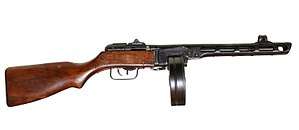
In 1940, the Russians introduced the 7.62×25mm PPD-40 and later the more easily manufactured PPSh-41 in response to their experience during the Winter War against Finland. The PPSh's 71-round drum magazine is a copy of the Suomi's. Later in the war they developed the even more readily mass-produced PPS submachine gun - all firing the same small but high-powered Tokarev cartridges. The USSR would go on to make over 6 million PPSh-41s and 2 million PPSs by the end of World War II. Thus, the Soviet Union could field huge numbers of submachine guns against the Wehrmacht, with whole infantry battalions being armed with little else. Even in the hands of conscripted soldiers with minimal training, the volume of fire produced by massed submachine guns could be overwhelming.
In 1941, Britain adopted the 9 mm Parabellum Lanchester submachine gun. Following the Dunkirk evacuation, and with no time for the usual research and development for a new weapon, it was decided to make a direct copy of the German MP 28. However this gun, the Lanchester, proved to be difficult and expensive to manufacture. Shortly thereafter, the simpler STEN submachine gun was developed, which was much cheaper and faster to make. Over 4 million STEN Guns were made during World War II. Indeed, the STEN was so cheap and easy to produce that towards the end of World War II as their economic base approached crisis, Germany started manufacturing their own copy (the MP 3008) . After the war, the British replaced the STEN with the Sterling submachine gun. Britain also used many M1928 Thompson submachine guns during World War II.
The United States and its allies used the Thompson submachine gun, especially the simplified M1. However, the Thompson was still expensive and slow to produce. Therefore, the U.S. developed the M3 submachine gun or "Grease Gun" in 1942, followed by the improved M3A1 in 1944. While the M3 was no more effective than the Tommy Gun, it was made primarily of stamped parts and welded together, and so, it could be produced much faster and at fraction of the cost of a Thompson. It could be configured to fire either .45 ACP or 9mm Luger ammunition. The M3A1 was among the longest serving submachine guns designs, being produced into the 1960s and serving in US forces into the 1990s.
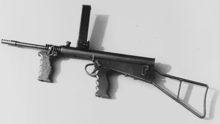
The Owen Gun is a 9mm Parabellum Australian submachine gun designed by Evelyn Owen in 1939. The Owen is a simple, highly reliable, open bolt, blowback SMG. It was designed to be fired either from the shoulder or the hip. It is easily recognisable, owing to its unconventional appearance, including a quick-release barrel and butt-stock, double pistol grips, top-mounted magazine, and unusual offset right-side-mounted sights. The Owen was the only entirely Australian-designed and constructed service submachine gun of World War II and was used by the Australian Army from 1943 until the mid-1960s, when it was replaced by the F1 submachine gun. Only about 45,000 Owens were produced during the war for a unit cost of about A$30.
Experience in close-range city combat led to the German military desiring a weapon representing a compromise between the high fire volume of the SMG and the accuracy of a full-size rifle; after a false start with the FG 42, this led to the development of the MP 44 select-fire assault rifle, the first weapon to be called such. In the years following the war, this new format would begin to gradually replace the submachine gun in military use to a large, but not total, extent.
After World War II
After World War II, "new submachine gun designs appeared almost every week to replace the admittedly rough and ready designs which had appeared during the war. Some (the better ones) survived, most rarely got past the glossy brochure stage."[10] Most of these survivors were cheaper, easier and faster to make than their predecessors. As such, they were widely distributed.
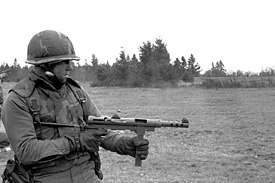
In 1945, Sweden introduced the 9 mm Parabellum Carl Gustav M/45 with a design borrowing from and improving on many design elements of earlier submachine-gun designs. It has a tubular stamped steel receiver with a side folding stock. The M/45 was widely exported, and especially popular with CIA operatives and U.S. Special Forces during the Vietnam War. In U.S. service it was known as the "Swedish-K". In 1966, the Swedish government blocked the sale of firearms to the United States because it opposed the Vietnam War. As a result, in the following year Smith & Wesson began to manufacture an M/45 clone called the M76.
In 1946, Denmark introduced the Madsen M-46, and in 1950, an improved model the Madsen M-50. These 9 mm Parabellum stamped steel SMGs featured a unique clamshell type design, a side folding stock and a grip-safety on the magazine housing. The Madsen was widely exported and especially popular in Latin America, with variants made by several countries.
In 1948, Czechoslovakia introduced the Sa vz. 23 series. This 9 mm Parabellum SMG introduced several innovations: a progressive trigger for selecting between semi-automatic and full auto fire, a telescoping bolt that extends forward wrapping around the barrel and a vertical handgrip housing the magazine and trigger mechanism. The vz. 23 series was widely exported and especially popular in Africa and the Middle East with variants made by several countries. The vz. 23 inspired the development of the Uzi submachine gun.[11]
In 1949, France introduced the MAT-49 to replace the hodgepodge of French, American, British, German and Italian SMGs in French service after World War II. The 9 mm Parabellum MAT-49 is an inexpensive stamped steel SMG with a telescoping wire stock, a pronounced folding magazine housing and a grip safety. This "wildebeast like design" proved to be an extremely reliable and effective SMG, and was used by the French well into the 1980s. It was also widely exported to Africa, Asia and the Middle East.
1950s
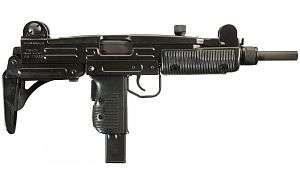
In 1954, Israel introduced a 9 mm Parabellum open-bolt, blowback-operated submachine gun called the Uzi (after its designer Uziel Gal). The Uzi was one of the first weapons to use a telescoping bolt design with the magazine housed in the pistol grip for a shorter weapon. The Uzi has become the most popular submachine gun in the world, with over 10 million units sold,[12] more than any other submachine gun.[13]
In 1959, Beretta introduced the Model 12. This 9 mm Parabellum submachine gun was a complete break with previous Beretta designs.[14] It is a small, compact, very well made SMG and among the first to use telescoping bolt design.[14] The M12 was designed for mass production and was made largely of stamped steel and welded together.[14] It is identified by its tubular shape receiver, double pistol grips, a side folding stock and the magazine housed in front of the trigger guard. The M12 uses the same magazines as the Model 38 series.
1960s
In the 1960s, Heckler & Koch developed the 9 mm Parabellum MP5 submachine gun. The MP5 is based on the G3 rifle and uses the same closed-bolt roller-delayed blowback operation system. This makes the MP5 more accurate than open-bolt SMGs, such as the Uzi. The MP5 is also one of the most widely used submachine guns in the world,[15] having been adopted by 40 nations and numerous military, law enforcement, intelligence, and security organizations.[16]
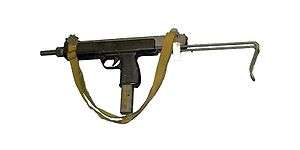
In 1969, Steyr introduced the MPi 69. This 9 mm Parabellum open-bolt, blowback-operated SMG has a telescoping bolt and is similar in appearance to the Uzi SMG.[17] It has a vertical pistol-grip into which the magazine is inserted, a longer horizontal front grip area and a telescoping wire buttstock. The receiver is a squared stamped steel tube which partly nestles inside a large plastic molding (resembling a lower receiver) which contains the forward hand-grip, vertical pistol-grip and the fire control group, making the MPi 69 one of the first firearms to use a plastic construction in this way. It has a progressive trigger and is also unusual among modern SMGs, as the MPi 69 is cocked by a dual-purpose lever also used as the front sling attachment point.[17]
1970s
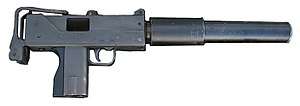
In the 1970s, extremely compact submachine guns, such as the .45ACP Mac-10 and .380 ACP Mac-11, were developed to be used with silencers or suppressors.[18] While these SMGs received enormous publicity, and were prominently displayed in films and television, they were not widely adopted by military or police forces.[18] These smaller weapons led other manufacturers to develop their own compact SMGs, such as the Micro-UZI and the H&K MP5K.
1980s
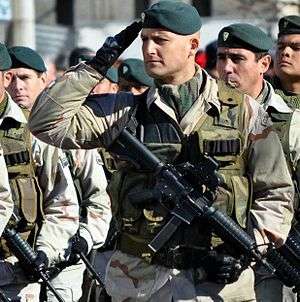
By the 1980s, the demand for new submachine guns was very low and could be easily met by existing makers with existing designs.[2] However, following H&K's lead, other manufacturers began designing submachine guns based on their existing assault rifle patterns. These new SMGs offered a high degree of parts commonality with parent weapons, thereby easing logistical concerns.
In 1987, Colt introduced the Colt 9mm SMG based on the M16 rifle.[19] The Colt SMG is a closed bolt, blowback operated SMG and the overall aesthetics are identical to most M16 type rifles. The magazine well is modified using a special adapter to allow the use of smaller 9mm magazines. The magazines themselves are a copy of the Israeli UZI SMG magazine, modified to fit the Colt and lock the bolt back after the last shot. The Colt is widely used by U.S. police forces and the USMC.[20]
1990s
In 1998, H&K introduced the last widely distributed SMG, the UMP "Universal Machine Pistol".[21] The UMP is a 9mm, .40 S&W, or .45 ACP, closed-bolt blowback-operated SMG, based on the H&K G36 assault rifle.[22][23] It features a predominantly polymer construction and was designed to be a lighter and cheaper alternative to the MP5.[22][24] The UMP has a side-folding stock and is available with four different trigger group configurations.[25] It was also designed to use a wide range of Picatinny rail mounted accessories [22][23]
2000s
In 2004, Izhmash introduced the Vityaz-SN a 9 mm Parabellum, closed bolt straight blowback operated submachine gun. It is based on the AK-74 rifle and offers a high degree of parts commonality with the AK-74.[26] It is the standard submachine gun for all branches of Russian military and police forces.[27][28]
.jpg)
In 2009, KRISS USA introduced the KRISS Vector family of submachine guns.[29] Futuristic in appearance, the KRISS uses an unconventional delayed blowback system combined with in-line design to reduce perceived recoil and muzzle climb. The KRISS comes in 9 mm Parabellum, .45 ACP, .40 S&W, 9×21mm, 10mm Auto, and .357 SIG. It also uses standard Glock pistol magazines.
2010s
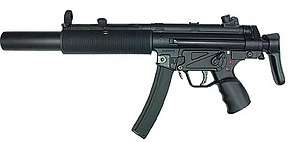
By 2010, compact assault rifles and personal defense weapons had replaced submachine guns in most roles.[2] Factors such as the increasing use of body armor and logistical concerns have combined to limit the appeal of submachine guns. However, SMGs are still used by police (especially SWAT teams) for dealing with heavily armed suspects and by military special forces units for close quarters combat, due to their reduced size, recoil and muzzle blast. Submachine guns also lend themselves to the use of suppressors, particularly when loaded with subsonic ammunition. Variants of the Sterling and Heckler & Koch MP5 have been manufactured with integral suppressors.
Personal defense weapons
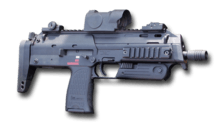
Developed during the late 1980s, the personal defense weapon (PDW) is touted as a further evolution of the submachine gun. The PDW was created in response to a NATO request for a replacement for 9×19mm Parabellum submachine guns. The PDW is a compact automatic weapon that uses specially designed rifle-like cartridges to fire armor-piercing bullets and are sufficiently light to be used conveniently by non-combatant and support troops, and as an effective close quarters battle weapon for special forces and counter-terrorist groups.[30][31]
Introduced in 1991, the FN P90 features a bullpup design with a futuristic appearance. It has a 50-round magazine housed horizontally above the barrel, an integrated reflex sight and fully ambidextrous controls.[32] A simple blowback automatic weapon, it was designed to fire the proprietary FN 5.7×28mm cartridge which can penetrate soft body armor.[30][31] The P90 was designed to have a length no greater than an average-sized man's shoulder width, to allow it to be easily carried and maneuvered in tight spaces, such as the inside of an infantry fighting vehicle.[32] The P90 is currently in service with military and police forces in over 40 nations.[33]
Introduced in 2001, the Heckler & Koch MP7 is a direct rival to the FN P90. It is a more conventional-looking design, and uses a short-stroke piston gas system as used on H&K's G36 and HK416 assault rifles, in place of a blowback system traditionally seen on submachine guns.[34] The MP7 uses 20-, 30- and 40-round box magazines and fires the proprietary 4.6×30mm ammunition which can penetrate soft body armor. Due to the heavy use of polymers in its construction, the MP7 is much lighter than older SMG designs, being only 1.2 kg (2.65 lb) with an empty 20-round magazine. The MP7 is currently in service with military and police forces in over 20 nations.
Name
There are some inconsistencies in the classification of submachine guns.[35] British Commonwealth sources often refer to SMGs as "machine carbines".[35][36] Other sources refer to SMGs as "machine pistols" because they fire pistol-caliber ammunition, for example, the MP-40 and MP5, where "MP" stands for Maschinenpistole ("Submachine gun" in German, but cognate with the English term "Machine pistol").[37] However, the term "machine pistol" is also used to describe a handgun-style firearm capable of fully automatic or burst fire,[38] such as the Stechkin, Beretta 93R and the H&K VP70. Also, Personal Defense Weapons such as the FN P90 and H&K MP7 are often called submachine guns.[35] In addition, some compact assault rifles, such as the Colt XM177, HK53 and AKS-74U, have been historically referred to as submachine guns as they served in the latter's role.[39]
See also
References
- "The Thompson submachine gun: shooting a 20th century icon. - Free Online Library".
- Military Small Arms Of The 20th Century. Ian Hogg & John Weeks. Krause Publications. 2000. p93
- David Crane (December 11, 2011). Submachine Guns (SMG’s): Outpaced by Today’s Modern Short-Barreled Rifles (SBR’s)/Sub-Carbines, or Still a Viable Tool for Close Quarters Battle/Close Quarters Combat (CQB/CQC)? Defense Review.
- Curley, Robert, ed. (2009). The Britannica Guide to Inventions That Changed the Modern World (First ed.). The Rosen Publishing Group. pp. 291–292. ISBN 1-61530-064-3.
- Military Small Arms of the 20th Century. 7th Edition. by Ian V. Hogg & John S. Weeks. Krause Publications. 2000. pages 116
- Frank Iannamico, American Thunder: The Military Thompson Submachine Gun 1928, 1928A1, M1, M1A1, Moose Lake Publishing, 2000.
- Dunlap, Roy F., Ordnance Went Up Front, Samworth Press, (1948), p. 58
- Military Small Arms of the 20th Century. 7th Edition. by Ian V. Hogg & John S. Weeks. Krause Publications. 2000. pages 118–120
- armies.http://world.guns.ru/smg/fi/suomi-m31-e.html
- Military Small Arms of the 20th Century. 7th Edition. by Ian V. Hogg & John S. Weeks. Krause Publications. 2000. pages 93–94
- Hogg, Ian V. (1979). Guns and How They Work. New York: Everest House. p. 157. ISBN 0-89696-023-4.
- McManners, Hugh (2003). Ultimate Special Forces. New York: DK Publishing. p. 157. ISBN 0-7894-9973-8. OCLC 53221575.
- Hackathorn, Ken (1995). "Using the Uzi". Fighting Firearms. Soldier of Fortune. 3 (1): 18–23.
- Military Small Arms of the 20th Century. 7th Edition. by Ian V. Hogg & John S. Weeks. Krause Publications. 2000. pages 138–139
- Hogg, Ian (2002). Jane's Guns Recognition Guide. Jane's Information Group. ISBN 0-00-712760-X.
- Tilstra, Russell C. (2012). Small Arms for Urban Combat. US: McFarland. p. 42. ISBN 978-0-7864-6523-1. Archived from the original on 2012-05-09.
- Military Small Arms of the 20th Century. 7th Edition. by Ian V. Hogg & John S. Weeks. Krause Publications. 2000. pages 97–98
- Military Small Arms of the 20th Century. 7th Edition. by Ian V. Hogg & John S. Weeks. Krause Publications. 2000. page 166
- "Archived copy". Archived from the original on 2003-05-18. Retrieved 2016-11-07.CS1 maint: archived copy as title (link)
- Military Small Arms Of The 20th Century. Ian Hogg & John Weeks. Krause Publications. 2000. p167
- "Heckler & Koch – Group Website". Heckler-koch.com. Retrieved 2009-06-26.
- Cutshaw, Charles Q (2011). Tactical Small Arms of the 21st Century: A Complete Guide to Small Arms From Around the World. Iola, Wisconsin: Gun Digest Books. p. 156. ISBN 978-1-4402-2709-7.
- Jane's Guns Recognition Guide. by Ian Hogg & Terry Gander. HaperCollins Publishers. 2005. page 192
- Dockery, Kevin (2007). Future Weapons. New York: Penguin Group US. pp. 383–385. ISBN 978-1-101-20618-8.
- Andrius Genys (2010). Submachine Guns and Assault Rifles. Military-Today.com. Andrius Genys. p. 2.
- https://web.archive.org/web/20111109005400/http://www.izhmash.ru/eng/product/vityaz.shtml Izhmash product page Vityaz SMG
- "New guns for Russia's cops – so what? - In Moscow's Shadows". In Moscow's Shadows. Retrieved 7 October 2014.
- "Исторические сведения ПП-19-01 "Витязь"/"Витязь-СН" - пистолет-пулемёт".
- "Products". KRISS Arms. Archived from the original on 20 January 2013. Retrieved 30 November 2012.
- Miller, David (2001). The Illustrated Directory of 20th Century Guns. London: Salamander Books Ltd. ISBN 9781840652451.
- Oliver, David (2007). "In the Line of Fire". Global Defence Review. Archived from the original on October 16, 2006. Retrieved October 19, 2009.
- Kevin, Dockery (2007). Future Weapons. New York: Berkley Trade. ISBN 9780425217504.
- Tirans, Ivars (2009). "Baltic Defence Research and Technology 2009 Conference Proceedings". Military Review: Scientific Journal for Security and Defence (ISSN 1407-1746), Nr. 3/4 (132/133), p 103.
- Cutshaw, Charles Q. (2003). "Heckler & Koch's cutting-edge compacts G36C and MP7 PDW: when less really is more". Guns Magazine. Archived from the original on 2012-07-08.
- Military Small Arms of the 20th Century. 7th Edition. by Ian V. Hogg & John S. Weeks. Krause Publications. 2000. pages 93–94.
- Sten Machine Carbine, by Peter Laidler & R Blake Stevens, Collector Grade Publications, Canada; 1ST edition (December 2000)
- Military Small Arms of the 20th Century. 7th Edition. by Ian V. Hogg & John S. Weeks. Krause Publications. 2000. pages 93–94 & 116–125.
- James Smyth Wallace. Chemical Analysis of Firearms, Ammunition, and Gunshot Residue. CRC Press. 2008. p. xxiii
- Military Small Arms of the 20th Century. 7th Edition. by Ian V. Hogg & John S. Weeks. Krause Publications. 2000. pages 125 & 166–167.
External links
| Wikimedia Commons has media related to Submachine guns. |


.jpg)

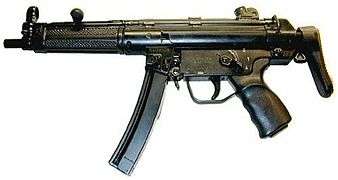
.jpg)
